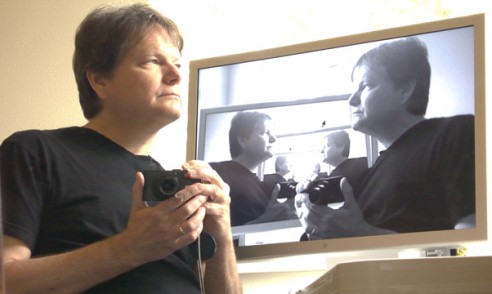 Richard was born with a genetic atrophy of the optic nerve. In optic atrophy less visual information is carried to the brain by the atrophied optic nerve causing an overall blurring and, in Richard’s case, enlarged blind spots in both eyes. It’s a bit like watching a television screen with lots of snow or visual noise. Richard experiences the enlarged blind spots as oval shaped, extremely blurry blobs near the center of each eye’s visual field.
Richard was born with a genetic atrophy of the optic nerve. In optic atrophy less visual information is carried to the brain by the atrophied optic nerve causing an overall blurring and, in Richard’s case, enlarged blind spots in both eyes. It’s a bit like watching a television screen with lots of snow or visual noise. Richard experiences the enlarged blind spots as oval shaped, extremely blurry blobs near the center of each eye’s visual field.
Despite being legally blind, Richard at an early age pursued a love of photography passed down to him by his father and grandfather. Even though he could not see the expressions on his subject’s faces, he became the yearbook photographer at his high school, devising clever ways of focusing a camera without having to see clearly. He spent his teenage summers hiking with his camera in the Sierra trying to emulate Ansel Adams.
However, resigned to the impossibility of being a blind photographer, Richard put his camera aside to study American History in college, still making photographs when he could. After college he struck a compromise with the “real world” by going into graphic design. Somehow being a legally blind graphic designer seemed less ridiculous and graphics still used his strong visual aesthetic.
After ten years of working in graphics though his love of photography drove him to return to school to study advertising photography at Rochester Institute of Technology in upstate New York. There he gravitated toward photographing close in, static still life subjects that he could focus on using strong magnifiers.
For the next ten years Richard practiced first commercial photography and then began a career in the fine arts, creating unusual, iconic, black and white still life images in his studio and exhibiting them at colleges, museums and private galleries. It was in the middle of this art career that Richard discovered Meir Schneider’s self healing work.
In between gallery shows, Richard would travel to San Francisco to spend a week or two working with Meir on his eyes. Richard’s vision improved dramatically. His glasses prescription dropped in half and his acuity increased from around 20/300 to near 20/100. Speaking in terms of the standard eye chart, this is an improvement from not quite seeing the top most, largest letter on the eye chart to seeing the third or fourth line down, a major step forward in acuity.
Alongside his two practices of photography and self healing, Richard was also a long time student of a nonreligious form of meditation called Time, Space and Knowledge. TSK, as it is called, was created by Tibetan lama Tarthang Tulku to make the esoteric, Buddhist meditation experience accessible to a Western, scientific mind. This secular meditation and philosophy divides both our everyday experience and our “peak” experiences into three aspects: time, space and knowledge. TSK provides us with a meditative path that leads from our ordinary experience to a more expansive, peak experience and then back again to a transformed, enriched ordinary experience.
In 2007 Richard enrolled in a Master of Fine Arts program in Interdisciplinary Arts in order to bring together his three life practices of photography, visual self healing and TSK. Through academic research and experimentation he created an integrated theory of art that he calls “Quantum Seeing.” Quantum Seeing uses three organizing principles from quantum physics to expand the practice of photography to include visual self healing and meditation. In the practice of Quantum Seeing the creative gaze merges with the healing gaze and with the meditative gaze.
Currently, Richard is living in San Francisco apprenticing with Meir Schneider, practicing self healing on himself and helping others to do the same. He also teaches TSK and Quantum Seeing in Berkeley. You can read his blog and follow his self healing progress by going to Richard’s Blog.
